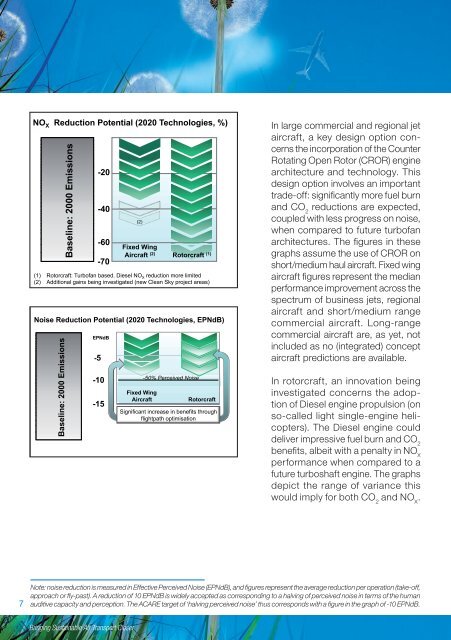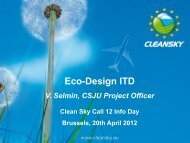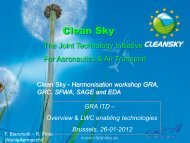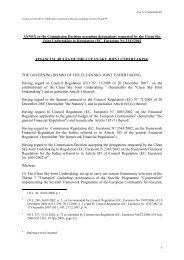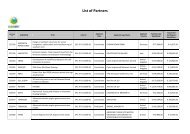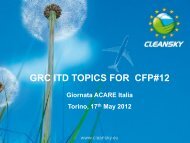Bringing Sustainable Air Transport Closer - Clean Sky
Bringing Sustainable Air Transport Closer - Clean Sky
Bringing Sustainable Air Transport Closer - Clean Sky
Create successful ePaper yourself
Turn your PDF publications into a flip-book with our unique Google optimized e-Paper software.
7<br />
NO X Reduction Potential (2020 Technologies, %)<br />
Baseline: 2000 Emissions<br />
-20<br />
-40<br />
-60<br />
-70<br />
<strong>Bringing</strong> <strong>Sustainable</strong> <strong>Air</strong> <strong>Transport</strong> <strong>Closer</strong><br />
Fixed Wing<br />
<strong>Air</strong>craft (2)<br />
(1) Rotorcraft: Turbofan based. Diesel NO X reduction more limited<br />
(2) Additional gains being investigated (new <strong>Clean</strong> <strong>Sky</strong> project areas)<br />
EPNdB<br />
-5<br />
-10<br />
-15<br />
(2)<br />
Rotorcraft (1)<br />
Noise Reduction Potential (2020 Technologies, EPNdB)<br />
Baseline: 2000 Emissions<br />
-50% Perceived Noise<br />
e Fixed Wing<br />
<strong>Air</strong>craft<br />
Rotorcraft<br />
Significant increase in benefits through<br />
flightpath optimisation<br />
In large commercial and regional jet<br />
aircraft, a key design option concerns<br />
the incorporation of the Counter<br />
Rotating Open Rotor (CROR) engine<br />
architecture and technology. This<br />
design option involves an important<br />
trade-off: signifi cantly more fuel burn<br />
and CO 2 reductions are expected,<br />
coupled with less progress on noise,<br />
when compared to future turbofan<br />
architectures. The fi gures in these<br />
graphs assume the use of CROR on<br />
short/medium haul aircraft. Fixed wing<br />
aircraft fi gures represent the median<br />
performance improvement across the<br />
spectrum of business jets, regional<br />
aircraft and short/medium range<br />
commercial aircraft. Long-range<br />
commercial aircraft are, as yet, not<br />
included as no (integrated) concept<br />
aircraft predictions are available.<br />
In rotorcraft, an innovation being<br />
investigated concerns the adoption<br />
of Diesel engine propulsion (on<br />
so-called light single-engine helicopters).<br />
The Diesel engine could<br />
deliver impressive fuel burn and CO 2<br />
benefi ts, albeit with a penalty in NO X<br />
performance when compared to a<br />
future turboshaft engine. The graphs<br />
depict the range of variance this<br />
would imply for both CO 2 and NO X .<br />
Note: noise reduction is measured in Effective Perceived Noise (EPNdB), and fi gures represent the average reduction per operation (take-off,<br />
approach or fl y-past). A reduction of 10 EPNdB is widely accepted as corresponding to a halving of perceived noise in terms of the human<br />
auditive capacity and perception. The ACARE target of ‘halving perceived noise’ thus corresponds with a fi gure in the graph of -10 EPNdB.


